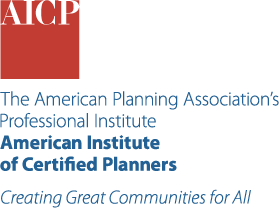Looking for education on this topic?
Check Out Our Passport Courses
Passport is your ticket to the training, experiences, and connections that will take you where you want to go in your planning career. Subscribe for unlimited access for one year to APA's extensive learning library of solution-oriented content facilitated by planners, for planners.
-
WHO/IFA Webinar 3 - Dementia Friendly Environments
July 2017by: Natalie TurnerThis recorded webinar considers the similarities and differences between the age-friendly communities framework and the dementia-friendly communities framework. -
WHO/IFA Webinar 7 - Social Inclusion: The Design of Age-Friendly Spaces
2018by: Ryan WoolrychThis recorded webinar advocates for the use of participatory research with older adults to better understand barriers to social inclusion. -
Intergenerational Solutions for Building Stronger Communities
October 2015by: Donna Butts, Cathy Choi, Ellen SchmedingThis recorded webinar discusses the benefits of intergenerational planning and highlights the success of this approach in San Diego. -
WHO/IFA Webinar 5 - Rural and Remote Age-Friendly Communities
November 2017by: Verena MenecThis recorded webinar highlights the importance of creating age-friendly communities in a rural context despite increasing urbanization. -
Age Friendly New York City Helps Seniors Stay Active
September 2013This video provides a useful introduction to the Age-Friendly NYC initiative. -
Age-Friendly Rural and Remote Communities: A Guide
2007by: Elaine Gallagher, Verena Menec, Janice KeefeThis guide was created for public and private stakeholders and individuals to facilitate the creation of rural age-friendly communities in Canada. -
An Alternative Age-Friendly Handbook
2014by: Sophie HandlerThis guide explores the age-friendly movement from a variety of perspectives and is intended to spark dialogue about how to create age-friendly urban spaces. -
Finding the Right Fit: Age-Friendly Community Planning
2013by: Ontario Ministry for Seniors and AccessibilityThis guide, designed for stakeholders in Ontario, Canada, walks through the four steps of the age-friendly community process. -
Global Age-Friendly Cities: A Guide
2007by: World Health OrganizationThis guide describes how to create more age-friendly cities through the framework of active aging. -
High-Density Housing for Families with Children Guidelines
March 1992by: City of VancouverThis guide is meant to inform development plans for high-density residential developments that are designed specifically for families with children in Vancouver, Canada. -
Assessing Community Needs for Child Care
2019by: Novella RuffinThis guide describes the importance of doing a community childcare needs assessment and includes a sample survey. -
Evaluating Your Age-Friendly Community Program
October 2014by: Margaret Neal, Iris WernherThis guide describes a six-step process for evaluating an age-friendly initiative. -
Making Your Community Livable for All Ages
2015by: Stephanie Krone FirestoneThis guide is designed to mobilize public and private stakeholders and individuals in creating an age-friendly community. -
The Accessible Community Bylaws Guide
September 2009by: Social Planning and Research Council of British ColumbiaThis collection of model policies provides a template to help cities enhance accessibility for older adults and people with disabilities. -
Planning for Children in New Vertical Communities
2017by: City of Toronto Planning DivisionThis guide is meant to ensure that the design plans of dense, multi-unit residential developments in Toronto, Canada are family-friendly. -
Atlanta, GA, Age-Friendly Atlanta Action Plan
Updated 2016This functional plan begins with a discussion of the city’s key strengths and challenges and walks through current conditions and goals for improvement using seven of the WHO’s eight domains of livability. -
Colorado Springs, CO, Age Friendly Colorado Springs
Adopted September 2016This functional plan includes recommendations organized by the WHO’s eight domains of livability. -
Austin, TX, Building an Age-Friendly Austin
Adopted November 2016This functional plan reports on the progress made toward making Austin an age-friendly city and identifies opportunities for improvement. -
ARC, GA, Live Beyond Expectations Strategic Plan
2015This functional plan identifies seven regional priority areas: transportation, caregiver support, long term supports and services, senior centers, behavioral health, information services, and housing. -
Columbus, OH, Age-Friendly Columbus Strategic Plan
Adopted November 2017This functional plan lists 17 strategies and corresponding actions to make the community more age-friendly. -
Age-Friendly America Database
Updated 2019This clearinghouse includes resources developed by or in partnership with Grantmakers in Aging related to building age-friendly communities. -
Denver, CO, Age Matters in Denver
Adopted 2018This functional plan uses seven of the WHO’s eight domains of livability to organize the needs, challenges, and recommendations for creating an age-friendly community. -
Sarasota County, FL, Age-Friendly Sarasota County Action Plan 2017-2020
Adopted May 2017This functional plan uses the WHO’s eight domains of livability to frame focus group data and propose age-friendly interventions. -
Age-Friendly World
Updated June 2019This clearinghouse shares information related to age-friendly community building from around the world. -
Evanston, IL, Age-Friendly Evanston Action Plan
Adopted 2016This functional plan proposes an action plan for each of the WHO’s eight domains of livability. -
Tompkins County, NY, Age Friendly Ithaca and Tompkins County Action Plan
Adopted December 2016This functional plan organizes the WHO’s eight domains of livability into the categories of Livability, Lifestyles, and Well-Being. -
Cobb County, GA, South Cobb Town Center
Adopted August 2010This subarea plan builds on the Atlanta Regional Commission’s age-friendly initiatives to create a more livable town center in Mableton, Georgia. -
Innovation for Age-Friendly Buildings, Cities, and Environments
November 2013by: José Martinez Usero, Frida Westholm, Louise TengstrandThis report compiles noteworthy practices from around Europe regarding age-friendly communities. -
Elk Grove, CA, Municipal Code
Updated May 2019The city’s zoning code includes density bonuses and other incentives for housing developments that include a childcare facility. -
Gardena, CA, Municipal Code
Updated April 2019The city’s zoning code includes incentives for housing developments that include a childcare facility. -
Planning for the Aging Population: Rural Responses to the Challenge
October 2012by: Lydia Morken, Mildred WarnerThis briefing paper highlights the differences between rural and urban responses to the survey featured in the 2011 Maturing of America report. -
Collaboration: The Key to Building Communities for All Generations
The Municipal Year Book, 2015by: Minkoung Choi, Mildred WarnerThis report emphasizes the need for collaboration among local government departments for creating age-friendly communities, especially in rural communities. -
Overview: Planning for Multigenerational Communities
April 2013by: Mildred Warner, Danielle Dunn, Xiaomeng LiThis briefing paper provides a short introduction to multigenerational planning and the series of issue briefs developed by the Planning Across Generations Project. -
Planning for Family Friendly Communities: Motivators, Barriers and Benefits
January 2013by: Mildred Warner, Joseph RukusThis briefing paper shares the results of a survey of 944 planners about their role in creating family friendly communities. -
Economic Importance of Families with Children
March 2012by: Mildred Warner, Rebecca Baran-ReesThis briefing paper explains the role of families with children in creating long-term economic stability through generational balance. -
Multigenerational Schoolyards: Capturing the Full Potential of Joint Use Agreements
April 2013by: Travis NorthThis briefing paper describes how multigenerational schoolyards can help create age inclusive communities. -
Age-Friendly NYC
Updated 2019This web page shares information about New York City’s age-friendly initiatives. -
Aging in Place
Updated 2019This web page provides an overview of the Aging in Place Initiative by Partners for Livable Communities. -
Henderson, NV, Development Code
Updated July 2019The city's development code belongs to the Group Housing, Marijuana-Related Uses, and Solar Energy collections. -
Why Parents Drive Children to School: Implications for Safe Routes to School Programs
Journal of the American Planning Association, 75(3): 331-342, 2009by: Noreen McDonald, Annette AalborgThis article belongs to the Active Transportation and Age-Friendly Communities collections. -
Transportation That Works for All Walks of Life
PlannersWeb, April 2014by: Jennifer Wallace-Brodeur, Stuart AndreasonThis article belongs to the Active Transportation and Age-Friendly Communities collections. -
Bicycling: A Livability Fact Sheet
2014by: AARP, Walkable and Livable Communities InstituteThis fact sheet belongs to the Active Transportation and Age-Friendly Communities collections. -
Moving to Action: How Do We Respond to Anti-Black Racism in Urbanist Practices and Conversations?
June 2020This video and online training is part two of an ongoing series of conversations between five Black urbanists discussing their experience with anti-Black racism and other issues in the field of urbanism. -
Healthy, Equitable Transportation Policy: Recommendations and Research
2009by: Shireen MalakafzaliThis report belongs to the Active Transportation, Built Environment and Health, and Social Equity collections. -
Addressing Community Concerns: How Environmental Justice Relates to Land Use Planning and Zoning
July 2003by: Philip Rutledge, James Barnes Jr, Teodoro BenavidesThis report discusses the relationship between land use planning and zoning and environmental justice. -
Environmental Justice, Urban Revitalization, and Brownfields: The Search for Authentic Signs of Hope
December 1996by: National Environmental Justice Advisory CouncilThis report analyzes findings from public dialogues on urban revitalization and brownfields. -
All Aboard! Making Equity and Inclusion Central to Federal Transportation Policy
January 2009by: Victor RubinThis report establishes core principles for achieving transportation equity and provides recommendations for federal policy. -
Community Benefits Agreements: Making Development Projects Accountable
2002by: Julian Gross, Greg LeRoy, Madeline Janis-AparicioThis report introduces Community Benefits Agreements as a tool to ensure that new development benefits the community. -
Cleveland Policy Planning Report
1975This report, by the Cleveland Planning Department under the direction of Norman Krumholz, establishes social equity as the primary goal for the department. -
Toward Indigenous Planning? First Nation Community Planning in Saskatchewan, Canada
Journal of Planning Education and Research 36(4): 1-11, 2015by: S. Yvonne Prusak, Ryan Walker, Robert InnesThis article studies community planning efforts in Canadian First Nation reserves to explore the ways indigenous planning principles interact with settler planning processes.


